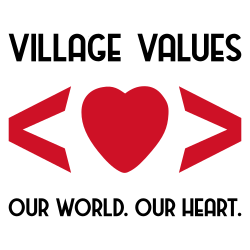Our Most Popular South Korean Flag-Inspired Designs
Our South Korean-inspired flags are among Village Values’ most popular designs, prompting us to explore the rich history and culture of South Korea. Here are some interesting facts:
Population: 51,611,000, 28th most populous in the world, with nearly 20% of its population living in the capital city of Seoul (1)
The "Miracle on the Han River" refers to South Korea's remarkable transformation from one of the world's poorest countries to an economic powerhouse, becoming a model of socio-economic growth. (2)
Approximately 70% of South Korea is mountainous, with Taebak Mountains along the east coast and Sobaek Mountains in the central region. About 3,000 small and mostly uninhabited islands lie off the western and southern coast, with Jeju Island as the most visited with its extinct volcano and highest peak, Hallasan Mountain (3)
United Nations Educational, Scientific and Cultural Organization (UNESCO) World Heritage Sites in South Korea: Haeinsa Temple Janggyeong Panjeon, the Depositories for the Tripitaka Koreana Woodblocks, Jongmyo Shrine, Seokguram Grotto and Bulguksa Temple, Changdeokgung Palace Complex, Hwaseong Fortress, Gochang, Hwasun and Ganghwa Dolmen Sites, Gyeongju Historic Areas, Jeju Volcanic Island and Lava Tubes and more (4)
Elaborate and vibrant festivals hosted all-year-round: Boryeong Mud Festival, Jeju Fire Festival, Seoul Lantern Festival, Busan International Film Festival, Andong Mask Dance Festival (5)
Hallyu, also known as the “Korean Wave” refers to the global popularity and influence of South Korean culture in entertainment, music, television dramas, movies, comics, fashion and beauty products, often prefaced with a “K” (e.g., K-pop, K-drama, K-beauty). BTS and Blackpink are two K-pop groups that have achieved global popularity. Squid Games and Parasite have also achived global acclaim, with the latter’s director, Bong Joon Ho, receiving an Oscar (6)
Most popular Korean dishes: Kimchi (pickled spicy dish), Bibimbap (rice dish), Bulgogi (meat dish), Banchan (assorted small dishes), Kimbap (rice dish), Tteokbokki (rice dish) (7)
The Korean concept of “haan” describes the sorrow and resilience of people who have endured oppression. Koohan Paik-Mander defines “haan” [“as “irreparable sorrow.” Others have called it “a mixture of sorrow and resentment, but with tinges of hope within the sadness and anger.” A more accurate definition might be achieved by describing how Han expresses itself—through storytelling, song, poetry, prayer. It is the language of humanity.”] (8)
Symbolism of the South Korean flag: Three parts: (I) white background representing purity and peace (II) Taeguk (red and blue yin-yang disc) symbolizing the balance of the universe and (III) trigrams symbolizing harmony and movement representing classical elements of heaven (upper left), fire (lower left), water (upper right) and earth (lower right) (9)
Source: (1) Ethnologue, (2) World Atlas (3) Wikipedia (4) UNESCO (5) Travelling South Korea (6) Wikipedia (7) Taste Atlas (8) Koohan Paik-Mander (9) World Atlas
Our Korean-Flag-Inspired Designs
More Designs: Multinational Patriot | We Heart Patriot | SuperEmpowered
Top Spoken Languages in South Korea
Korean
English
Chinese
Japanese
Vietnamese
Tagalog/Filipino
Official Language: Korean (10)
Source: (10) Traveling South Korea
A Few Korean Phrases
Of the top languages spoken in the United States, Korean ranks 8th! (13) A few Korean words and phrases to get us aspiring polyglots started:
Hello: Annyeonghaseyo (안녕하세요)
How are you?: Eotteohge jinaeseyo? (어떻게 지내세요?)
Good: Joh-ayo (좋아요)
Goodbye: Annyeonghi gaseyo (안녕히 가세요)
Thank You: Gamsahabnida (감사합니다)
You’re welcome: Cheonman eyo (천만에요)
Yes: Ne (네)
No: Aniyo (아니요)
Welcome: Hwan yeong (환영)
Please: Jebal (제발)
Excuse Me: Sillyehabnida (실례합니다)
Sorry: Mianhaeyo (미안해요)
What is your name? Ireumi mwo-eyo? (이름이 뭐에요?)
My name is: Nae ireumeun [NAME]ya (내 이름은 [NAME]야)
Let’s eat: Meokja (먹자)
I love you: Saranghaeyo (사랑해요)
Family: Gajok (가족)
Native speakers, how’d we do? Please let us know via connect@villagevalues.org or our form. Thank you [Gamsahabnida (감사합니다)] for reading.
Source: (13) DATAUSA: United States




































